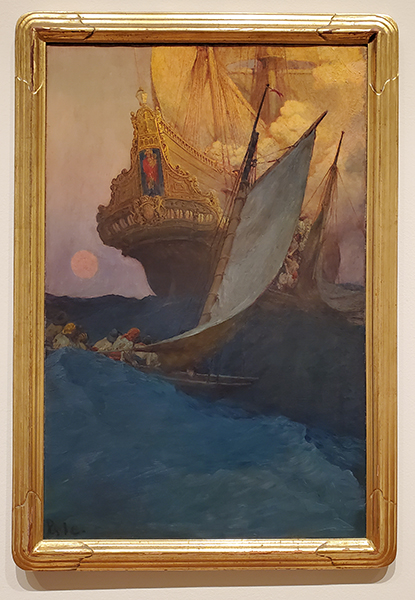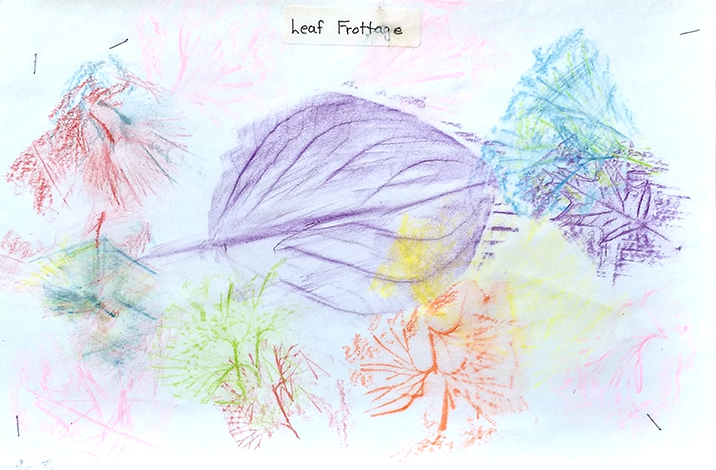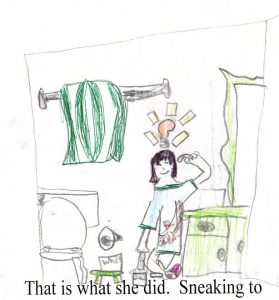We “arr” back for Pirates on the Brandywine, part II. Today’s post covers my visit to the Brandywine Museum of Art in Chadds Ford, Pennsylvania, & the illustrations of N.C. Wyeth. Part I covered Howard Pyle & the Delaware Art Museum.
To save reinventing the wheel, here is a brief biography from the museum.

My first known encounter with Wyeth’s artwork occurred in fourth grade. My class received a magazine called Weekly Reader, which provided reading, questions, and other exercises on a different topic each week such as nature, history, and literature. The Treasure Island edition contained excerpts from the first few chapters of Robert Louis Stevenson’s famed and influential tale. The illustrations paired with them were Wyeth’s Billy Bones & blind Pew. I found them gripping.
Captain Bill Bones (“All day he hung round the cove, or upon the cliffs, with a brass telescope”), 1911.
Old Pew (“Tapping up and down the road in a frenzy, and groping and calling for his comrades”), 1911.
Back then, why I found them gripping was perhaps not so simple to articulate. They certainly weren’t the usual fare for a fourth-grade girl who enjoyed carefully pasting vibrant Lisa Frank & Disney stickers on her school supplies. Thinking back to that time, it seems it was the presence and power they exuded and how well the imagination blends the story and the illustrations, creating an amalgamation greater than the parts. The description of Pew—his tap, tap, tapping, threatening demeanor, and delivery of the infamous black spot—without an illustration was enough to strike terror in the heart until recess. The compositions are simple but dramatic. (“Essential” may be a better word than “simple” given Howard Pyle’s lessons.) They exude presence. Light & dark values contrast strongly.
I discovered another intriguing quality on my in-person visit—for illustrations, they’re huge! The dramatic element was certainly not lost when they were scaled down for book publication, but the true size is more striking.
Like Pyle, Wyeth illustrated several historical pieces and adventure stories. Here is Wyeth’s cover artwork (1918) for Jules Verne’s The Mysterious Island, sequel to 20,000 Leagues under the Sea. There’s some glare, but you can see the non-titular area well enough.
I found it interesting but not surprising that he painted the title box right onto the canvas. Why waste time or materials on an area that wouldn’t be seen? These days, it seems more common that an artist paints the whole cover image and then the title is layered over the cover art digitally. The upside to that is flexibility (image scale, placement of text); there is also something nice about having the cover art also stand alone.
Captain Nemo here reminds me of Merlin–not just generally, but of another Wyeth illustration. Nemo was on display; Merlin was not. (Both are cropped here; click to see full size on the museum’s website.)
Merlin taking away the infant Arthur (“So the child was delivered unto Merlin, and so he bare it forth”) for The Boy’s King Arthur, 1917. Side note: for anyone interested in a historical and political exploration of King Arthur and Merlin, this lecture sponsored by Rising Tide Foundation is interesting.
This was new to me (the painting & the book): The Pledge for The Scottish Chiefs, 1921. Quite theatrical.
In addition to gallery collections, The Brandywine Museum offers studio tours of both N. C. and Andrew Wyeth. The N. C. studio tour included the house and studio, which I am pretty well convinced is bigger than the house. At least it gives that impression. The first photo is of the house; the rest are of the studio.




Wyeth made use of props, which you can see all around the studio, some small, and some large like this beautiful birch canoe.
This painting was not on display, but I thought you might like to see one with a canoe.
Hiawatha’s Fishing, 1907 (linked to museum website).
The mural in the second big room in the studio depicts William Penn and the new world (William Penn, Man of Vision · Courage · Action, 1932). To his back is England, and he looks toward America.
After the studio tour, I returned to the museum to finish viewing the exhibits and have a second look at some paintings. That said, I suppose it is time for Pirates on the Brandywine to conclude. I hope you have enjoyed “sea”-ing and learning about some swashbuckling American illustration and the illustrators. ‘Til next time, fair winds & full canvas, whether of wind or paint.

































